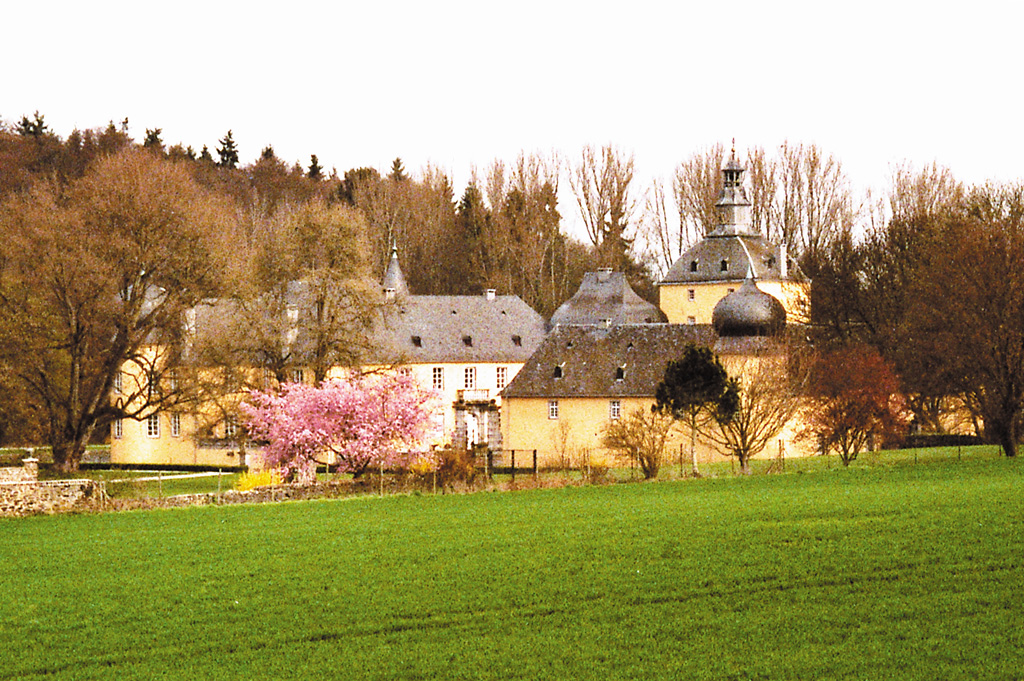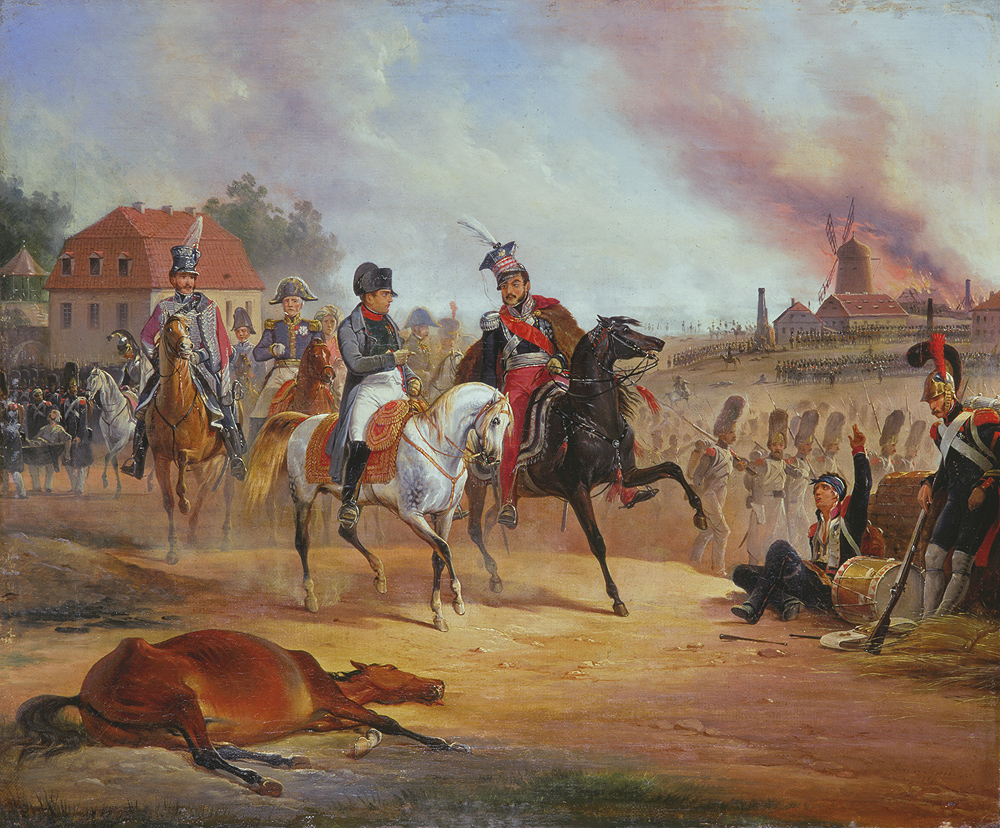|
Principality Of Leyen
The Principality of Leyen was a Napoleonic German state which existed 1806–1814 in Hohengeroldseck, in the west of modern Baden-Württemberg. The House of Leyen had acquired many districts in western Germany, and eventually these were inherited by the Leyen line of counts at Adendorf. In 1797, France defeated the Holy Roman Empire and all lands west of the Rhine were lost. Following the defeat of Austria in December 1805, most of the smaller German princely states were mediatized, with the glaring exception of Leyen, which was spared because the ruling Count was nephew to Archchancellor Karl Theodor von Dalberg,Heinrich von Treitschke, ''History of Germany in the Nineteenth Century, Volume 1'', page 270. a close collaborator of Napoleon's. In 1806, Count Philip Francis of Adendorf was raised to a Prince, and his lands were renamed to the 'Principality of Leyen'. The territory formed an enclave surrounded by Baden. Prince Philip Francis, like many other members of the Confedera ... [...More Info...] [...Related Items...] OR: [Wikipedia] [Google] [Baidu] |
Napoleonic Wars
{{Infobox military conflict , conflict = Napoleonic Wars , partof = the French Revolutionary and Napoleonic Wars , image = Napoleonic Wars (revision).jpg , caption = Left to right, top to bottom:Battles of Battle of Austerlitz, Austerlitz, Fall of Berlin (1806), Berlin, Battle of Friedland, Friedland, Battle of Aspern-Essling, Aspern-Essling, French occupation of Moscow, Moscow, Battle of Leipzig, Leipzig and Battle of Paris (1814), Paris , date = {{start and end dates, 1803, 5, 18, 1815, 11, 20, df=yes({{Age in years, months, weeks and days, month1=05, day1=18, year1=1803, month2=11, day2=20, year2=1815) , place = Atlantic Ocean, Caucasus, Europe, French Guiana, Mediterranean Sea, North Sea, West Indies, Ottoman Egypt, Egypt, East Indies. , result = Coalition victory , combatant1 = Coalition forces of the Napoleonic Wars, Coalition forces:{{flagcountry, United Kingdom of Great Britain and ... [...More Info...] [...Related Items...] OR: [Wikipedia] [Google] [Baidu] |
County Of Adendorf
Wachtberg is a municipality in the Rhein-Sieg district, of North Rhine-Westphalia, Germany. It is situated approximately 15 km south of Bonn. In 2021 the Wachtberg municipality had approximately 20,352 inhabitants. Geology Geological situation Wachtberg is located on the left bank of the Rhine between the Kottenforst forest to the north, the Voreifel to the west, the lower Middle Rhine Valley to the east and the Ahrgebirge to the south. The municipality was named after one of its highest points, the Wachtberg, located between Berkum and Villip (extinct for 25 million years, now with a height of 258 m). Political division The municipality was formed in 1969 with the Bonn Act (formally ''Gesetz zur kommunalen Neugliederung des Raumes Bonn'', abbreviated as the ''"Bonn-Gesetz"'') and merged 13 now incorporated villages: * Adendorf (with Klein-Villip) * Arzdorf * Berkum * Fritzdorf * Gimmersdorf * Holzem * Ließem * Niederbachem * Oberbachem (with Kürrighoven) * Pech * ... [...More Info...] [...Related Items...] OR: [Wikipedia] [Google] [Baidu] |
1806 Establishments In Europe
Eighteen or 18 may refer to: * 18 (number) * One of the years 18 BC, AD 18, 1918, 2018 Film, television and entertainment * ''18'' (film), a 1993 Taiwanese experimental film based on the short story ''God's Dice'' * ''Eighteen'' (film), a 2005 Canadian dramatic feature film * 18 (British Board of Film Classification), a film rating in the United Kingdom, also used in Ireland by the Irish Film Classification Office * 18 (''Dragon Ball''), a character in the ''Dragon Ball'' franchise * "Eighteen", a 2006 episode of the animated television series ''12 oz. Mouse'' Science * Argon, a noble gas in the periodic table * 18 Melpomene, an asteroid in the asteroid belt Music Albums * ''18'' (Moby album), 2002 * ''18'' (Nana Kitade album), 2005 * '' 18...'', 2009 debut album by G.E.M. * ''18'' (Jeff Beck and Johnny Depp album), 2022 Songs * "18" (5 Seconds of Summer song), from their 2014 eponymous debut album * "18" (One Direction song), from their 2014 studio album ''Four' ... [...More Info...] [...Related Items...] OR: [Wikipedia] [Google] [Baidu] |
Former States And Territories Of Baden-Württemberg
A former is an object, such as a template, gauge or cutting die, which is used to form something such as a boat's hull. Typically, a former gives shape to a structure that may have complex curvature. A former may become an integral part of the finished structure, as in an aircraft fuselage, or it may be removable, being used in the construction process and then discarded or re-used. Aircraft formers Formers are used in the construction of aircraft fuselage, of which a typical fuselage has a series from the nose cone to the empennage, typically perpendicular to the longitudinal axis of the aircraft. The primary purpose of formers is to establish the shape of the fuselage and reduce the column length of stringers to prevent instability. Formers are typically attached to longerons, which support the skin of the aircraft. The "former-and-longeron" technique (also called stations and stringers) was adopted from boat construction, and was typical of light aircraft built unt ... [...More Info...] [...Related Items...] OR: [Wikipedia] [Google] [Baidu] |
Lists Of Princes
A list is a set of discrete items of information collected and set forth in some format for utility, entertainment, or other purposes. A list may be memorialized in any number of ways, including existing only in the mind of the list-maker, but lists are frequently written down on paper, or maintained electronically. Lists are "most frequently a tool", and "one does not ''read'' but only ''uses'' a list: one looks up the relevant information in it, but usually does not need to deal with it as a whole".Lucie Doležalová,The Potential and Limitations of Studying Lists, in Lucie Doležalová, ed., ''The Charm of a List: From the Sumerians to Computerised Data Processing'' (2009). Purpose It has been observed that, with a few exceptions, "the scholarship on lists remains fragmented". David Wallechinsky, a co-author of ''The Book of Lists'', described the attraction of lists as being "because we live in an era of overstimulation, especially in terms of information, and lists help us ... [...More Info...] [...Related Items...] OR: [Wikipedia] [Google] [Baidu] |
Erwein, 2nd Prince Of Leyen
Karl Eugen Damian ''Erwein'', Fürst von der Leyen und zu Hohengeroldseck (3 April 1798 – 17 May 1879) was a German nobility, Baden nobleman, Bavarian landowner and Major General. Early life He was born on 3 April 1798 at Wiesentheid, the son of Sophia Therese Walpurgis von Schönborn (1772–1810) and Philip Francis, Prince of Leyen, Philipp Franz Wilhelm Ignaz Peter von der Leyen (1766–1829), who briefly ruled the Principality of Leyen. His sister Amalia, was the wife of Count Louis Tascher de La Pagerie (a first cousin of the French Empress Josephine Tascher de La Pagerie, Josephine). His paternal grandparents were Franz Georg Karl Anton House of Leyen, von der Leyen und zu Hohengeroldseck and the former Baroness Marianne von der Leyen, Maria Anna Sophia of Dalberg (sister of Karl Theodor Anton Maria von Dalberg, who later became Prince-Primate of the Confederation of the Rhine). Through his sister Amalia, he was an uncle of Charles, Duc de Tascher de La Pagerie. His mater ... [...More Info...] [...Related Items...] OR: [Wikipedia] [Google] [Baidu] |
Battle Of Leipzig
The Battle of Leipzig, also known as the Battle of the Nations, was fought from 16 to 19 October 1813 at Leipzig, Saxony. The Coalition armies of Austria, Prussia, Sweden, and Russia, led by Tsar Alexander I, Karl von Schwarzenberg, and Gebhard von Blücher decisively defeated the ''Grande Armée'' of French Emperor Napoleon Bonaparte. Napoleon's army also contained Polish and Italian troops, as well as Germans from the Confederation of the Rhine (mainly Saxony and Württemberg). The battle was the culmination of the German campaign of 1813 and involved about 560,000 soldiers, 2,200 artillery pieces, the expenditure of 400,000 rounds of artillery ammunition, and 133,000 casualties, making it the largest battle of the Napoleonic Wars, and the largest battle in Europe prior to World War I. Decisively defeated, Napoleon was compelled to return to France while the Sixth Coalition kept up its momentum, dissolving the Confederation of the Rhine and invading France early the ... [...More Info...] [...Related Items...] OR: [Wikipedia] [Google] [Baidu] |
Baden
Baden (; ) is a historical territory in southern Germany. In earlier times it was considered to be on both sides of the Upper Rhine, but since the Napoleonic Wars, it has been considered only East of the Rhine. History The margraves of Baden originated from the House of Zähringen. Baden is named after the margraves' residence, Hohenbaden Castle in Baden-Baden. Hermann II of Baden first claimed the title of Margrave of Baden in 1112. A united Margraviate of Baden existed from this time until 1535, when it was split into the two Margraviates of Baden-Durlach and Baden-Baden. Following a devastating fire in Baden-Baden in 1689, the capital was moved to Rastatt. The two parts were reunited in 1771 under Margrave Charles Frederick. The restored Margraviate with its capital Karlsruhe was elevated to the status of electorate in 1803. In 1806, the Electorate of Baden, receiving territorial additions, became the Grand Duchy of Baden. The Grand Duchy of Baden was a state ... [...More Info...] [...Related Items...] OR: [Wikipedia] [Google] [Baidu] |
Karl Theodor Anton Maria Von Dalberg
Karl Theodor Anton Maria von Dalberg (8 February 1744 – 10 February 1817) was a Catholic German bishop and statesman. In various capacities, he served as Archbishop of Mainz, Prince of Regensburg, Arch-Chancellor of the Holy Roman Empire, Bishop of Constance and Worms, Prince-Primate of the Confederation of the Rhine and Grand Duke of Frankfurt. Dalberg was the last Archbishop-Elector of Mainz. Early life and career Born in Mannheim,Bischof, Franz Xaver. "Dalberg, Karl Theodor Anton Maria v.", ''Religion Past and Present 2013 as a member of the House of Dalberg, he was the son of [...More Info...] [...Related Items...] OR: [Wikipedia] [Google] [Baidu] |
Prince-elector
The prince-electors ( pl. , , ) were the members of the Electoral College of the Holy Roman Empire, which elected the Holy Roman Emperor. Usually, half of the electors were archbishops. From the 13th century onwards, a small group of prince-electors gained the privilege of electing the King of the Romans. The king would then later be crowned Emperor by the pope. Charles V (elected in 1519) was the last emperor to be crowned (1530); his successors assumed the title "Elected Emperor of the Romans" (; ) upon their coronation as kings. The dignity of elector carried great prestige and was considered to be behind only the emperor, kings, and the highest dukes. The electors held exclusive privileges that were not shared with other princes of the Empire, and they continued to hold their original titles alongside that of elector. The heir apparent to a secular prince-elector was known as an electoral prince (). Rights and privileges Electors were rulers of ( Imperial Estates) ... [...More Info...] [...Related Items...] OR: [Wikipedia] [Google] [Baidu] |
Austria
Austria, formally the Republic of Austria, is a landlocked country in Central Europe, lying in the Eastern Alps. It is a federation of nine Federal states of Austria, states, of which the capital Vienna is the List of largest cities in Austria, most populous city and state. Austria is bordered by Germany to the northwest, the Czech Republic to the north, Slovakia to the northeast, Hungary to the east, Slovenia and Italy to the south, and Switzerland and Liechtenstein to the west. The country occupies an area of and has Austrians, a population of around 9 million. The area of today's Austria has been inhabited since at least the Paleolithic, Paleolithic period. Around 400 BC, it was inhabited by the Celts and then annexed by the Roman Empire, Romans in the late 1st century BC. Christianization in the region began in the 4th and 5th centuries, during the late Western Roman Empire, Roman period, followed by the arrival of numerous Germanic tribes during the Migration Period. A ... [...More Info...] [...Related Items...] OR: [Wikipedia] [Google] [Baidu] |







